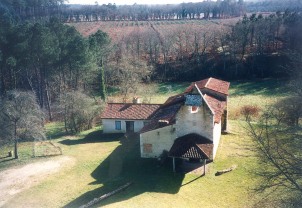Following my arrival in Retjons in 1968, I discovered the site of Lugaut and fell under its spell.
From that moment forward, I devoted nearly all of my vacations to clearing brush and making the chapel accessible. At one point in this time, I received a novel machine from a friend of mine in the U.S., it was called, a "weed wacker". This triangular cutting tool worked more like a chainsaw, and was not very practical to tackle bramble bushes. Between the weight of this machine, its vibrations and especially its exposed exhaust (which seemed intent on sticking to my arm and burning it) I quickly resumed the old method, billhook and saw.
In 1969, we hosted a group of individuals from the government who specialize in historical buildings under the supervision of Mr. Kefélian,who was assisted by a researcher at the C.N.R.S. I believe his name was Jean-Claude. Leaving home, we needed half an hour to reach Lugaut through the forest.
Once inside, we cleared the nave of vegetation. To recover the original paving, we started to strip the soil of the remnants of vegetation, examining and sifting each shovelful- at this rate, it would have taken us years. Often, we stayed late into the night, stargazing. It was during one of these evenings, we finally "peeked" inside the choir and partially cleared a slab which had a peripheral groove. Having already seen this kind of slab before, Jean-Claude explained it could be the base of a sarcophagus, and that the peripheral groove was used by pilgrims to recover a few drops of the clear juice as a relic.
While the team was busy sifting soil (which did not appeal to me much) I volunteered to help the surveyor, Mr. Cier, and Jean-Claude. While Mr. Cier measured and dictated the numbers, Jean-Claude wrote them and I planted stakes and held the tape measure. We ended up surveying and measuring the entire cemetery and the two meadows below (the second meadow which is near the 25m bridge, is now planted with pines).
As he knew with other chapels, Jean-Claude was almost certain that there was a crypt underneath Lugaut, which would have been used "to access water and put the objects of worship in a safe location in case of attack of vandals". So, we dug along the east wall; at the base of the crack, Jean-Claude noted encouraging signs. However, we lacked time and money and had to reseal the hole.
The following year, I was limited by military obligations and could not participate in excavations, the results of which I never had the chance to know of.
It must be said that at the time, public opinion and the local authorities had little interest (if not hostile) in these old stones and paintings. The rare occasions to ask questions about this seemingly controversial topic, have brought me no good answer.
For a long time I have wanted to collect some testimonies, always pushed back by life events and now some of the witnesses are gone. So even if my research is still in its infancy, I decided to put everything online as it comes in.
Bonne navigation,
Patrick Delpy.



)
